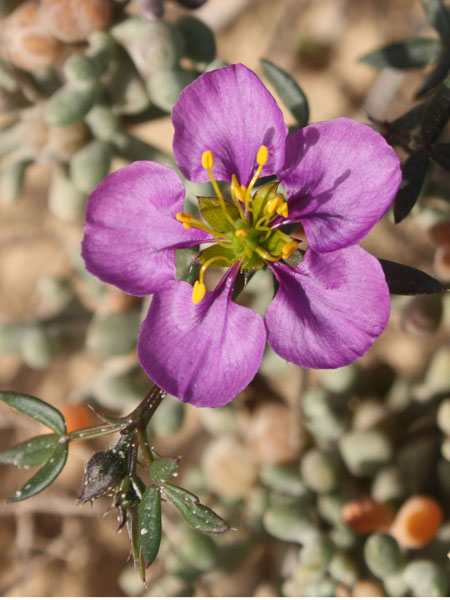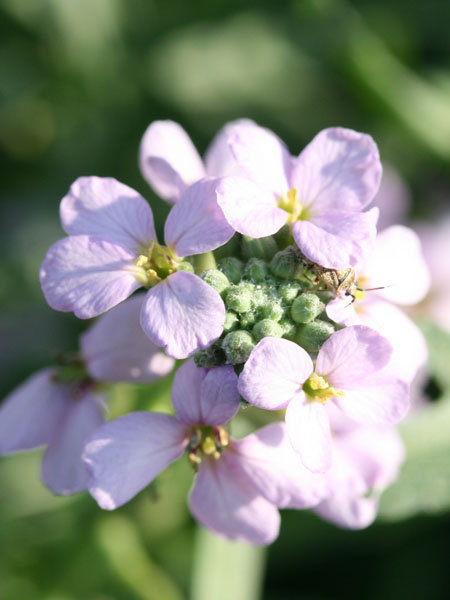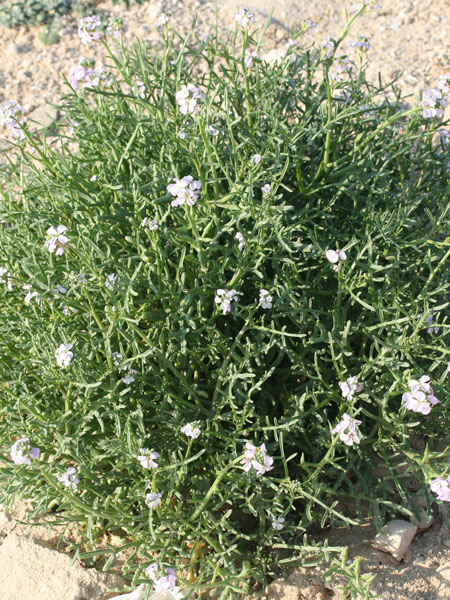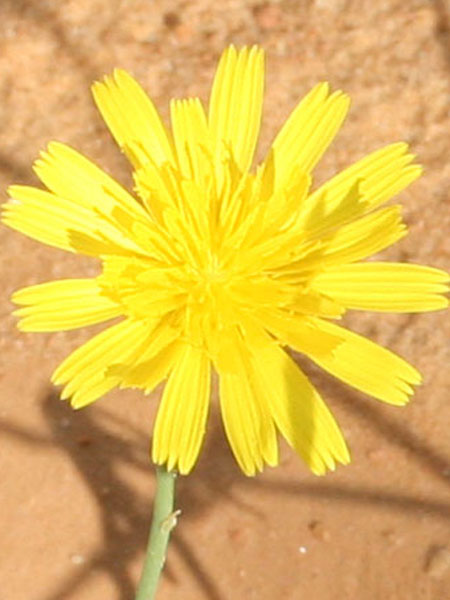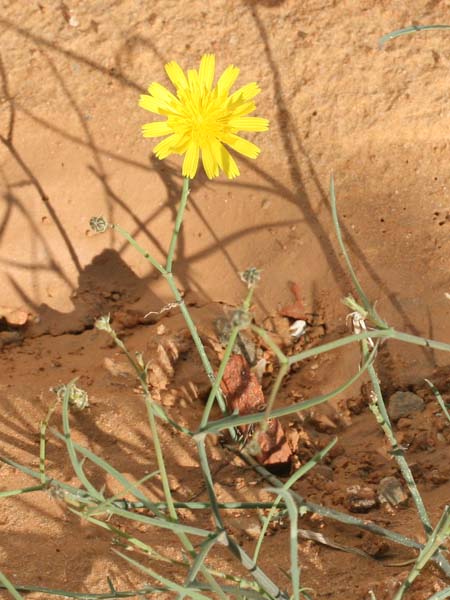Euphorbia paralias
Kingdom : Plantae / النّباتات
Division : Spermaphyta / البذريات
Clade : Magnoliophyta or Angiospermae / مستورات البذور
Class : Eudicotyledoneae / ذات الفلقتين
Order : Malpighiales / رتبة الملبيغيات
Family : Euphorbiaceae / الفصيلة اليَتُّوعِيَّة أو الفَرْبَيُونِيَّة أو الفصيلة اللبنّية أو الحلابيّة
Genus : Euphorbia
species : paralias
Chromosomes: 2n=16
Protologue
L., Sp. Pl., ed. 1, 458 (1753)
Synonyms
Tithymalus paralias (L.) Hill in Aiton, Hort. Kew., ed. 1, 172 (1768).
Common names
Tunisia Arabic English French Tamazight
الحلّاب
Sea spurge
Euphorbe maritime
Euphorbe des sables
mmū-lbayna
rremada
Toxic
yes
Edible
no
Latex
yes
Botanic description
Genus description
"Unisexual flowers, aperians gathered in cyathes simulating a hermaphrodite flower. Each cyath is composed of a central female flower surrounded of 5 small unilateral cymes of male flowers, all within a cup-shaped involucre with 4-5 narrow, erect lobes or curved in, separated by wide sinuses, each occupied by a fleshy gland rejected outside. Male flower reduced to 1 stamen articulated on its pedicel, pedicelled female flower, formed of 3 Welded carpels.Over above three 1-ovulate boxes, more or less welded styles, bifid, persistent. Tricoque capsule. Seed usually wattled. Cyathes arranged generally in umbel. Latex plants.
Species description
"Glabrous plant, glaucous, with a long ligneous strain rower.
Stems robust, erect or ascending usually 20-60 cm. bare denuded Leaves nested, glaucous, thick, coriaceous, upright, concave, entire, linear or linear-oblong. Flowers yellow-green Inflorescence cyath, umbel with 3-5 ray dichotomes, corded-reniform floral bracts, crescent glands with short horns and divariates. Fruits subglobose capsule of 4 on 6 mm, glabrous, with fairly deep furrows; granular hulls on the back. Seeds Smooth ovoid seeds, very small caruncle.
Botanic References
Pottier-Alapetite G.(1981). Flore de la Tunisie Angiospermes –Dicotylédones (Apétales- Dialypétale , Première partie). Imprimerie Officielle de la République Tunisienne (Eds),478 p. Edouard LE FLOC’H, Loutfy BOULOS et Errol VELA. (2010). Catalogue synonymique commenté de la FLORE DE TUNISIE. République Tunisienne, Ministère de l’Environnement et du développement durable, Banque Nationale de Gènes. 500 p www.theplantlist.org
Biology
Life form perennial Type form Therophyte Photosynthesis C3,C4,CAM
Phenology
Blooming
JanuaryFebruaryMarchAprilMayJuneJulyAugustSeptemberOctoberNovemberDecember
Fruiting
JanuaryFebruaryMarchAprilMayJuneJulyAugustSeptemberOctoberNovemberDecember
Map Localization
Ecology
Adaptation Halophilic plant that likes salt meadows and sebkhas of coastal areas. Appears in delta areas and coastal ponds, under the influence of the saltwater body. The soil is loamy and floodable. Salt bladder yes Invasive no
Geographical distribution
Localization Biocimatic stage Annuel pluviometry (mm) GPS Sousse (Hergla, Août 2016) Inferior semi-arid 331 36° 2'14.01"N / 10°29'45.06"E Cap Bon (Tazeka, Février 2016) Superior semi-arid 444 36°32'22.46"N / 10°50'56.47"E Cap Bon ( Korba, Mars 2014) Superior semi-arid 444 36°35'13.96"N / 10°52'32.34"E Cap Bon (Menzel Temim, Fév. 2016) Superior semi-arid 444 36°46'0.75"N / 11° 0'18.62"E
General uses
Medicinal uses
"The plant contains a poisonous milky and viscous juice: the toxic white latex, which causes irritation of the skin and dangerous in case of contact with the eyes. It was once used in folk medicine in application against warts. It is actually a means developed by Euphorbia to protect itself from herbivores. Plants of the genus Euphorbia secrete a very toxic latex due to the euphorbone it contains. Many studies have also suggested that the application of medicinal plant extracts to known anti-diabetic treatments has fewer side effects than synthetic drugs.
NOTE : This website is not that of herbal medicine and assumes no responsibility for the negative effects of the use of plants. Seek advice from a professional before using a medicinal plant.
Systems / Organs / Effects
Reproductive System Anti-cancer
Description of the seeds
Form Globular External structure any Ornamentation punctuated Type of seed albumen Average length of 10 seeds 3 ± 0.1 (mm) Average width of 10 seeds 2.6 ± 0.1(mm) Average thickness of 10 seeds 2.6 ± 0.1(mm) Average mass of 100 seeds (g)
Test results
TPC DPPH ABTS+ FRAP Year mg GAE g-1 MS CI50 g ml-1 CI50 g ml-1 CE50 g ml-1 72,75± 3,54 0,12± 0,01 6,53± 0,09 9,57± 0,14 2016 Total Phenols content(TPC), Anti-radical potentialities against (DPPH, ABTS), Ferric reducing antioxidant power(FRAP)
Molecules : ADN / Proteins
Chromosomes : 16 Uniprot NCBI
Tunisian references
Besbes Hlila M, Majouli K, Harzallah Skhiri F, Ben Jannet, H, Aouni M, Mastouri M, Selmi B. (2016). Total phenolic compounds, antioxidant potential and ?-glucosidase inhibition by Tunisian Euphorbia paralias L. Journal of Coastal Life Medicine. 4(8): 628-633.
Other references
Braun-Blanquet, J. (1932). ‘Plant sociology: the study of plant communities’ (McGraw-Hill, New York). Butcher, R.W. (1961). ‘A new illustrated British flora.’ (Leonard Hill Limited, London). Davies, S.J.J.F. (1985). Regenerating mobile sand dunes at Eyre. In ‘Royal Australian Ornithologists Union Report No. 9.’ pp. 66-72. (Royal Australian Ornithologists Union, Moonee Ponds). Harden, G. (1990). ‘Flora of New South Wales Volume1.’ (New South Wales University Press, Kensington). Heyligers, P.C. (1985). The impact of introduced plants on fore dune formation in south eastern Australia. Proceedings of the Ecological Society of Australia. 14, 23-41. Heyligers, P.C. (1985). The impact of introduced plants on fore dune formation in south eastern Australia.Proceedings of the Ecological Society of Australia 14, 23-41. Heyligers, P.C. (1994). A survey of sea spurge occurrences in southern New South Wales. Nature in Eurobodalla 9, 70-74. Nugent, D. (1993). ‘Otway National Park inventory of resources and uses.’ (Victorian Department of Conservation and Natural Resources, Melbourne). Özbilgin, S., Citoğlu S.G., (2012). Uses of some Euphorbia species in traditional medicine in Turkey and their biological activities. Turk J. Pharm. Sci. 9(2), 241-256. Ranwell, D.S. (1975). ‘Ecology of salt marshes and sand dunes.’ (Chapman and Hall, London).
























